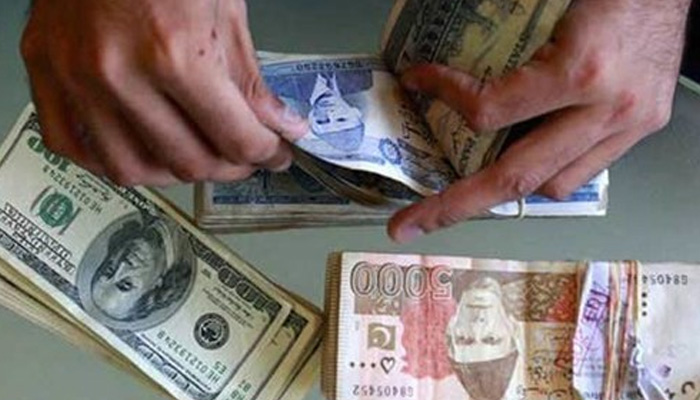Rupee falls to 3-mth low of 128.50
The rupee fell to almost three-month low at 128.50 against the US dollar in the open market on Monday, taking cue from equity mayhem and as frantic buyers rushed to build up position on prospects of interbank depreciation.
KARACHI: The rupee fell to almost three-month low at 128.50 against the US dollar in the open market on Monday, taking cue from equity mayhem and as frantic buyers rushed to build up position on prospects of interbank depreciation.
The rupee dropped one percent per dollar — its lowest since July 19. Dealers said continued uncertainty over a fresh deal with the International Monetary Fund (IMF) contributed to panic buying.
“The rupee closed to 128.50 against the dollar compared with previous close of 127.30, tracking losses in the equity market,” Zafar Paracha, general secretary of the Exchange Companies Association of Pakistan (ECAP) said.
“Strong demand by the general public and the retail investors, fears of currency devaluation, and the looming uncertainty about the IMF program are putting pressure on available dollars in the kerb market.”
The rupee closed at 124.26 / dollar on Monday in the interbank market compared with Friday’s close of 124.25. Analysts expected that the central bank would depreciate the local currency by another five percent in the near term to arrest further decline in the balance of payments amid increasing oil prices and tracking trend in the regional currency market.
The rupee lost around 18 percent of its value against the US dollar in the interbank market since December 2017. The currency came under a renewed pressure in the kerb market despite a warning by the central bank to the exchange companies last week to ensure foreign exchange stability.
Paracha said money changers might have a meeting with the State Bank of Pakistan soon to “discuss reasons related to the latest volatility in the open market”. “Bearish sentiments lingered amid lower foreign exchange reserve of the country,” he added.
Official reserves dipped by 6.94 percent or $627 million as of September 28. The reserves held by the State Bank of Pakistan declined to $8.408 billion from $9.036 billion in previous week. That compared with $9.8 billion at the end of last fiscal year. The reserves were sufficient to cover six-eight weeks of imports.
The rupee was trading at 126/126.50 against the US dollar since August on hopes that Imran Khan’s government would bring economic and political stability following the general elections in July.
The local currency has, however, started facing pressure since last week when it weakened to 128 against the greenback. The rupee traded as weaker as 129/130 per dollar on Monday’s morning.
The ECAP, however, directed the exchange houses to ensure the sale not beyond 128.50. A dealer said investors are waiting if the government would approach the IMF and further devalue the currency to ease pressure on the balance of payments.
“Today, we’ve seen few sellers but more frantic buyers,” the dealer said. The IMF called for a greater exchange rate flexibility to tackle rising current account deficit.
“Policies should include more exchange rate flexibility and monetary policy tightening, further fiscal adjustment anchored in a medium-term consolidation strategy, and strengthening the performance of key public enterprises together with further increases in gas and power tariffs,” the IMF said in a statement following a weeklong visit of its team to Pakistan last month.
The Bretton Woods financial institution said additional decisive policy action, anchored in a comprehensive strategy, and significant external financing would be needed in the near term. IMF termed the recent measures, including rupee depreciation, interest rate hike and gas tariffs increase as “necessary steps that go in the right direction”.
-
 Relieve Eczema Symptoms This Winter With Simple Steps
Relieve Eczema Symptoms This Winter With Simple Steps -
 Prince Harry Faces Marital Tensions As King Charles Offers Olive Branch
Prince Harry Faces Marital Tensions As King Charles Offers Olive Branch -
 South Korea, Italy Strengthen Ties To Bolster AI Technology, Business, Defence Cooperation
South Korea, Italy Strengthen Ties To Bolster AI Technology, Business, Defence Cooperation -
 Elon Musk Shares Crucial Advice As China’s Birth Rate Hits Record Low Since 1949
Elon Musk Shares Crucial Advice As China’s Birth Rate Hits Record Low Since 1949 -
 Kelly Clarkson Finally Quitting Morning Show?
Kelly Clarkson Finally Quitting Morning Show? -
 'Confident' Prince Harry Breaks Silence After Returning To Britain
'Confident' Prince Harry Breaks Silence After Returning To Britain -
 James Gunn Reveals What Caused Wonder Woman Casting Rumors
James Gunn Reveals What Caused Wonder Woman Casting Rumors -
 Tesla Emerges Early Winner As Canada Welcomes Chinese EVs: Here’s Why
Tesla Emerges Early Winner As Canada Welcomes Chinese EVs: Here’s Why -
 New Hope For People With Obesity As Failed Drug Offers Cure
New Hope For People With Obesity As Failed Drug Offers Cure -
 Prince Harry Considering ‘half-in, Half-out’ Royal Role Amid UK Trip?
Prince Harry Considering ‘half-in, Half-out’ Royal Role Amid UK Trip? -
 CBS Finally Airs Trump’s Full Interview 'pulled' Earlier After White House Threatens To Sue
CBS Finally Airs Trump’s Full Interview 'pulled' Earlier After White House Threatens To Sue -
 Robert Irwin Gets Honest About Being In South Africa After 'DWTS' Run In LA
Robert Irwin Gets Honest About Being In South Africa After 'DWTS' Run In LA -
 Queen Elizabeth’s Icy Response To Andrew, Jeffrey Epstein Scandal Revealed
Queen Elizabeth’s Icy Response To Andrew, Jeffrey Epstein Scandal Revealed -
 Trump Vows To Neutralize ‘Russian Threat’ From Greenland, Raising Arctic Stakes
Trump Vows To Neutralize ‘Russian Threat’ From Greenland, Raising Arctic Stakes -
 Green Day Revealed As Super Bowl 2026 Opening Act
Green Day Revealed As Super Bowl 2026 Opening Act -
 Trump's Greenland Tariff ‘blackmail’ Sparks EU Retaliation: Is ‘trade Bazooka’ Next?
Trump's Greenland Tariff ‘blackmail’ Sparks EU Retaliation: Is ‘trade Bazooka’ Next?




